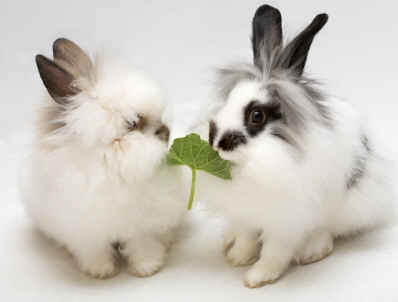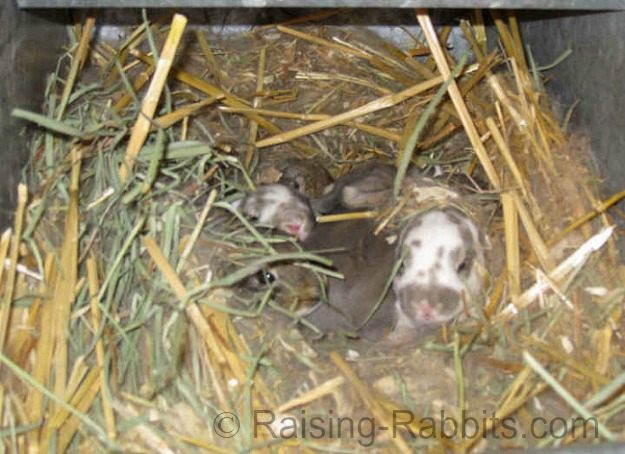Rabbit Rhythms
March 2020 Newsletter

Alright, rabbit breeders! On your mark... get set... GO!
Now is an optimal time to be breeding rabbits as they are happy, healthy, and hormonal. Grasses are green, and high in protein so both bucks and does are especially fertile during this time. Learn why rabbits get excited around spring, how to optimize this time of year, and what to watch out for during this craze.
Is your rabbit having trouble breeding? Is she a little on the chunkier side? This could be inhibiting your rabbit's ability to conceive and produce healthy kits. Read about the dangers of rabbit obesity, how it affects breeding, and how to help your rabbit regain a normal weight.
What to do when all the new kits arrive?! Do you leave them alone or intervene? Is there an appropriate time to intervene? Karen has answers for you below.
Rabbits in the News: One Indonesian rabbit species that is not doing so well at this time is the highly endangered Sumatran Striped Rabbit. Its endangered status has worsened due to trafficking via social media. Discover why this breed is so rare, and what you can do to help out the cause!
Rabbit Spring Fling
 If you thought Lady and the Tramp was cute, check this out!
If you thought Lady and the Tramp was cute, check this out!Late winter is when rabbit breeding begins to start but spring is when the mating season goes into full gear.
The temperature is rising and daylight hours are growing. The grass is perfectly green and nutritious. New growth, spring green grasses provide up to 22% protein during the time when does are producing hormones urging them to mate, are preparing for new litters, and are already beginning to kindle their first litters. The combination of increased protein concentration, increasing daylight hours, and raging hormones makes for some VERY excited bunnies.
Take note rabbit breeders! If you haven’t started breeding, now is the time. Be aware however that along with regular pregnancies, an increase in false pregnancies may occur as well. Female rabbits may mount other female rabbits as a show of dominance, which may induce the mounted female to ovulate and have a false pregnancy.
Housing All Those Littermates!
Baby rabbits grow and mature at breakneck speed. You might swear that they go from newborn to 12 weeks old in 4 weeks flat. You barely pull the nestbox out of the cage, and soon you have to wean the kits, and then separate them into their own cages. It all feels like it happens in the blink of an eye.
We HIGHLY recommend that about a week after weaning, you separate each buckling into its own cage. Doelings, on the other hand, can live together peaceably for many more weeks. Here's how to sex those kits accurately.
At breeding time however, the safest scenario is to NOT house sibling does together, as disasters are known to happen to kits, even accidentally, when a non-maternal doe without a litter is forced into proximity with the other doe's kits.
If, due to cage space, you need to house a buckling and doeling together (because two bucks are liable to fight), it will be very smart to get them separated from each other before 12 weeks of age. Because if you don't, they will start establishing dominance, puberty will hit, and you'll find yourself the owner of yet another litter of babies presented just for you!
Rabbit Obesity
Spoiling your rabbit with treats and food is very easy to do; I mean rabbits are just so stinking cute! But much like humans, a rabbits' health must be watched. They shouldn't just eat anything and everything. Allowing your rabbit to become overweight could have some serious ramifications such as diseases, heart problems, and trouble breeding. Luckily, if your rabbit is obese, it is not the end of the world! There are simple steps one can take to help your rabbit lose weight. Check out our new article about Obese Rabbits for more information on the causes, consequences, and solutions for rabbit obesity.
Your Rabbit Health Questions Answered
"New Litter - No Clue What I'm Doing!"
 12-day-old kits in nest box. It is a good practice to check nest boxes from day one.
12-day-old kits in nest box. It is a good practice to check nest boxes from day one.*****Meghan Wonders*****
"My doe unexpectedly had kits on Monday (February 2020).
"I've read a lot of conflicting things. Some say to leave the kits alone, don't touch them at all, which is what I have done The doe seems to be keeping the nest clean and feeding them. There is movement in the big mass of fur and the nest does not seem wet. They are now 3 days old.
"Should I clean out the nest? Should I be checking on each of them? I had been going with the 'nature knows best'theory (despite desperately wanting to see them). The doe seems to be happy and doing her job."
***** Karen Sez *****
Meghan is right; nature usually does know best. Animals are born with instincts and rabbit moms typically know exactly what to do once they have given birth, thanks to those genetically coded maternal instincts. The doe in question is being a terrific mom, as far as Meghan knows.
But, what if there happens to be a rotting dead baby in the nest? What if there isn't quite enough nesting materials to soak up any moisture in the nest? What if improper ventilation results in weeping of unwanted moisture down the sides of the carrier into the nest? How will one know if the doe needs nutritional help with milk production if one doesn't check the little tummies of the babies?
Yes, nature does know best, but this doesn't mean you can't or shouldn't take a peek into the nest, just to ensure that the "nature" in your care is well-cared-for.
In all but the most extreme situations, there will be NO problem at all with checking the nest right way as soon as you discover the rabbit has kindled her litter, assuming the doe has completed the kindle and is lounging away from the nest contentedly.
Section III of of The Rabbit Raising Problem Solver covers everything about rabbit production from breeding to weaning. You'll find a lot of guidance on this topic in Chapter 8, Kindling and Newborn Kit Care, starting on page 169.
Rabbits in the News: Rabbit Trafficking via Social Media
The Sumatran Striped Rabbit is a highly endangered breed of rabbit found in a small area of Sumatra, Indonesia. A research team in Indonesia found a peculiar rabbit kit on WhatsApp for sale for $356. It is the only native rabbit species to Indonesia, and had not been seen for over 10 years by scientists. As a result, any illegal trade of it could be extremely damaging to its population. The kit ended up dying before it was sold on social media.
Unfortunately social media has made illegal trade of endangered species extremely easy. Advertising, communication, and shipping has never been easier for poachers and traffickers. However, trafficking of the Sumatran Striped is also due to the lack of protection. It is only listed as data deficient on the IUCN and the rarity of this rabbit makes it extremely difficult for the government to manage its population. We however, can use social media for good by spreading the word about this endangered species.
Click here for more information on this incident.
We have more details about the Sumatran Striped Rabbit here.
Like this Rabbit Rhythms March 2020 Newsletter?
Maybe your friends would too...
- Forward this email to your friends!
- Now you can 'like' us on every page of Raising-Rabbits.com
- Visit (and 'like' us) on Facebook as well...
https://www.facebook.com/RaisingRabbits
Your friends at Raising-Rabbits.com wish you a wonderful March 2020.
Enjoy your rabbits!
Double-Value Guarantee
Our policy is to always OVER-deliver
on value,
which is why your purchase is fully covered by our
Double-Value
Guarantee.
Go ahead - take any of our e-books for a test drive. Peruse our detailed informational and educational e-books. Examine our plans for building rabbit cages, runs, or metal or PVC hutch frames. Check out the Rabbit Husbandry info e-books.
If you aren't completely satisfied that your e-book purchase is worth at least double, triple or even quadruple the price you paid, just drop us a note within 45 days, and we'll refund you the entire cost. That's our Double-Value Guarantee.
Note: When you purchase your
e-books, they will be in PDF format, so you can download them to any device that
supports PDF format. We advise making a back-up copy to a drive or cloud
account. If the books are lost, you can also purchase another copy from Raising-Rabbits.










New! Comments
Have your say about what you just read! Leave me a comment in the box below.